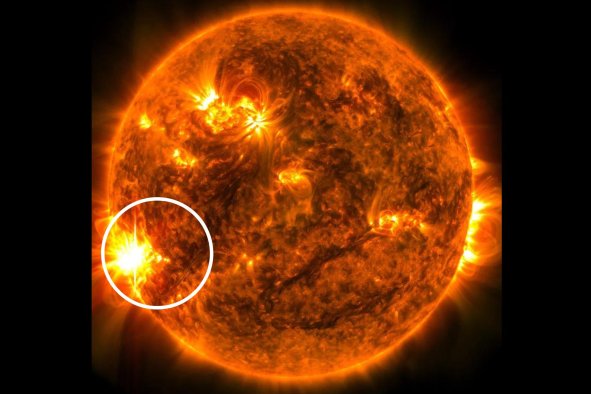An asteroid floating in our solar system has been discovered to have a very weird and unique double moon—and it might just change the way we think about how planets form.
The asteroid—officially titled "Dinkinesh" but nicknamed "Dinky"—was found to have a tiny moon orbiting it when NASA's Lucy spacecraft flew past it in November 2023. However, subsequent data revealed that the moon is actually two moons stuck together, marking the first time such a system has been observed around an asteroid.
Now, a new paper in the journal Nature has revealed how this moon—known as a contact binary—may have formed, shedding light on how celestial bodies interact.
"Our ultimate goal is to understand the formation of celestial bodies," study co-author Jessica Sunshine, a professor of astronomy at the University of Maryland, said in a statement. "How do planets form? How was Earth formed? We know that big planets are formed by smaller bodies, so studying these little asteroids lets us see how materials behave and interact on a smaller scale. With Dinky and the other asteroids we're flying by, we're laying the groundwork for understanding how planets are made."
Dinkinesh is situated in the asteroid belt between Mars and Jupiter, and measures about 2,360 feet across. As Lucy approached the asteroid, it saw that its moon—named Selam—was actually two small moons joined together. Each of these two moons were around the same size at about 700 feet across, which is a rare trait among the other scant contact binaries we have seen in our solar system.
Selam takes around 52.5 hours to orbit Dinkinesh, with an incredibly short distance of just under 2 miles between the two. The researchers estimate that Dinkinesh has a mass of about 16 times that of Selam.
"There's a lot more complexity in these small bodies than we originally thought," said Sunshine. "With the additional observations taken by the spacecraft, we were able to better analyze features such as Dinkinesh's rotation speed and Selam's orbit pattern. We also have a better understanding of what materials they're possibly made of, bringing us a step closer to learning just how terrestrial bodies are created."
The Lucy spacecraft's high-resolution imaging system, L'LORRI, captured detailed images of Dinkinesh and Selam, revealing a trough and a ridge on Dinkinesh's surface. These features suggest that a portion of Dinkinesh's material was ejected into space due to its fast rotation and the bright glare of the sun.
The researchers theorize that this ejecta could possibly have led to the formation of Selam, with the rest showering back down onto the asteroid to form the ridges seen on the surface of Dinkinesh.
In the paper, the researchers note that this discovery offers new insights into the formation and structural dynamics of celestial bodies, challenging current theories and opening up new avenues for research into how systems like Dinkinesh's form and evolve.
"One of the things that's critical to understanding how planets like Earth got here is understanding how objects behave when they hit each other, and to understand that we need to understand their strength," co-author Hal Levison, a researcher at Southwest Research Institute, Boulder, Colorado, said in a statement.
"Basically, the planets formed when [smaller objects like asteroids] orbiting the sun ran into each other. Whether objects break apart when they hit or stick together has a lot to do with their strength and internal structure."
The findings also have potential for comparative studies with the asteroid Didymos and its companion, which was also explored by NASA's DART mission. Despite being in different regions—Dinkinesh in the main asteroid belt and Didymos near Earth—both systems exhibit striking similarities.
"I'm personally very excited to compare the Didymos binary system with this one, especially as they appear to share many similarities such as size, general shape and possibly composition despite being in totally different parts of the solar system," Sunshine said.
"The Didymos binary system is located in a near-Earth environment while the Dinkinesh system is located much farther away from Earth in the main asteroid belt," she said. "They have very different features but we think they may have undergone similar processes to become what we know of them today."
The Lucy mission, launched in October 2021, aims to explore 11 asteroids over its 12-year journey, focusing primarily on the Trojan asteroids orbiting near Jupiter. Dinkinesh was a warm-up target added to the mission's schedule, demonstrating the spacecraft's capabilities and setting the stage for more ambitious encounters in the future. After a gravity-assist flyby of Earth in December 2024, Lucy will head towards another main belt asteroid, Donaldjohanson in 2025, before moving on to the Trojan asteroids in 2027.
Do you have a tip on a science story that Newsweek should be covering? Do you have a question about asteroids? Let us know via science@newsweek.com.
Disclaimer: The copyright of this article belongs to the original author. Reposting this article is solely for the purpose of information dissemination and does not constitute any investment advice. If there is any infringement, please contact us immediately. We will make corrections or deletions as necessary. Thank you.



